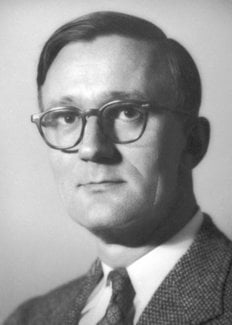Polykarp Kusch
Biographical

Polykarp Kusch was born in Blankenburg, Germany, on the 26th January, 1911, the son of a clergyman. He has lived in the United States since 1912 and is a citizen of that country. He received his early education in the midwest of the United States. His original professional goal was in the field of chemistry, but soon after beginning his course of studies at the Case Institute of Technology, Cleveland, Ohio, his interest rapidly shifted to physics. In 1931 he received the B.S. degree in physics. He carried on his graduate study at the University of Illinois which awarded him the M.S. degree in 1933 and the Ph.D. degree in 1936. At Illinois he worked on problems in the field of optical molecular spectroscopy under the guidance of Professor F. Wheeler Loomis. He worked with Professor John T. Tate at the University of Minnesota in the field of mass spectroscopy during 1936-1937.
Since 1937 Kusch has been associated with the Department of Physics of Columbia University, New York City, except for interruptions engendered by World War II. These years were spent in research and development on microwave generators at the Westinghouse Electric Corporation, the Bell Telephone Laboratories and Columbia University. The experience was important not only in that it gave him knowledge of microwave methods, but also in that it suggested application of the special techniques of vacuum tube technology to a large range of problems in experimental physics.
Kusch has been a Professor of Physics at Columbia University since 1949. From his first days at Columbia, he has been intimately associated with Professor I.I. Rabi in his programme of research on atomic, molecular and nuclear properties and phenomena by the method of molecular beams. The direction in which his own research has been directed has been greatly influenced by this long association. His research has dealt principally with the small details of the interactions of the constituent particles of atoms and of molecules with each other and with externally applied fields. The establishment of the reality of the anomalous magnetic moment of the electron and the precision determination of its magnitude was part of an intensive programme of postwar research with atomic and molecular beams. Later, he has also become interested in problems in chemical physics to whose experimental study he has applied the molecular beams technique.
Professor Kusch has been awarded honorary Sc.D. degrees of the Case Institute of Technology, the Ohio State University, the University of Illinois and Colby College. He was elected to the membership in the National Academy of Sciences (USA) in 1956.
In recent years he is increasingly concerned with problems of education, especially that of educating the young to understand a civilization strongly affected by the knowledge of science and by the techniques that result from this knowledge.
Kusch married Edith Starr McRoberts; they had three daughters. His wife died in 1959 and he was married to Betty Pezzoni in 1960.
This autobiography/biography was written at the time of the award and first published in the book series Les Prix Nobel. It was later edited and republished in Nobel Lectures. To cite this document, always state the source as shown above.
Polykarp Kusch died on March 20, 1993.
Nobel Prizes and laureates
Six prizes were awarded for achievements that have conferred the greatest benefit to humankind. The 12 laureates' work and discoveries range from proteins' structures and machine learning to fighting for a world free of nuclear weapons.
See them all presented here.
